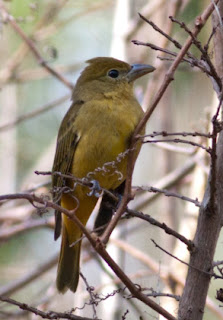My husband and I are avid birders, and enjoy seeing lots of different kinds of birds in our yard. Our yard has its own life list in fact, with 124 species. Just in case anyone else's yards are jealous, I should point out to be fair that our yard has a lot of advantages in this respect, including being partially within and adjacent to a tidal saltmarsh in close proximity to the Chesapeake Bay and a migratory flyway (that and admittedly liberal rules for adding birds to the list, including flyovers.)
So when we see a bird from the window that looks unusual, we tend to drop what we're doing and run for binoculars and, if necessary, field guides. The window over the kitchen sink looks out over the backyard... we don't have as many dishes as we once did. This weekend I looked out to see a small yellowish bird poking around a half-barrel "pond" we have on the deck. I thought it might be a Common Yellowthroat, which would be a nice bird, but I needed my binoculars to get a good look. Better than a yellowthroat, it was a Summer Tanager! This is not at all a normal bird for this area in January. It is called a "summer" tanager, after all. It's a bird of the treetops, where it eats mainly insects. It flew up into a tree but my husband was able to get some photos of it before it left.
I love to garden (although I don't really have a naturally green thumb) and one of the things I love about it is seeing little creatures in my garden, birds and butterflies, etc. A lot of my gardening effort and daydreaming is focused on gardening for wildlife, including planting and encouraging native plants and removing invasives (this last involves much more effort in my case than I would really like). Doug Tallamy, in his book called "Bringing Nature Home," makes the point that native plants are of key importance for wildlife, especially birds, because those are for the most part the only plants that sustain large numbers of insects of various species. Even birds that we think of as seed-eaters feed their young on protein-rich insects. So I choose native plants wherever possible.
But I am a gardener, and I have other interests too. Like many others, I'm greedy for flowers and I want to have blooms all year round if possible. In January, about all I have in bloom is the Mahonia that was planted by a previous owner of my house.
I think this is Mahonia bealei, and it is not native to my area. In the winter and early spring, it consistently attracts honeybees, which aren't native either (but are also very welcome). I suppose the bees have somewhere else to go in the summer because I don't see them nearly as often then. Honeybees can survive cold temperatures by huddling together in the hive, but when it's warm enough for me to be brave enough to be out sniffing the perfume of the Mahonia, it often seems to be warm enough for them too.
It wasn't a good day to be a honeybee collecting nectar from the Mahonia this Saturday though. But it wasn't such a bad day to be a Summer Tanager far from her usual winter home.
Bryan also got this photo, exhibit A. I'm not sure if this wrong-way visitor will make it through the winter if she can't get oriented and go south. But with the help of the non-native Mahonia and honeybees, she might have a better chance. Gardening for the birds seems to be like that -- full of surprises.



I became a back yard birder when we moved to this house 8 years ago. I have about 60 species identified with the yard, pond and woods, with the most recent an osprey..very cool....Michelle
ReplyDeleteNeat! I got started as an adult too not having any experience in either gardening or birding in my youth. I figure when I retire (which isn't soon) I'll have time to start up a few more hobbies and maybe start getting good at these ones.
Delete